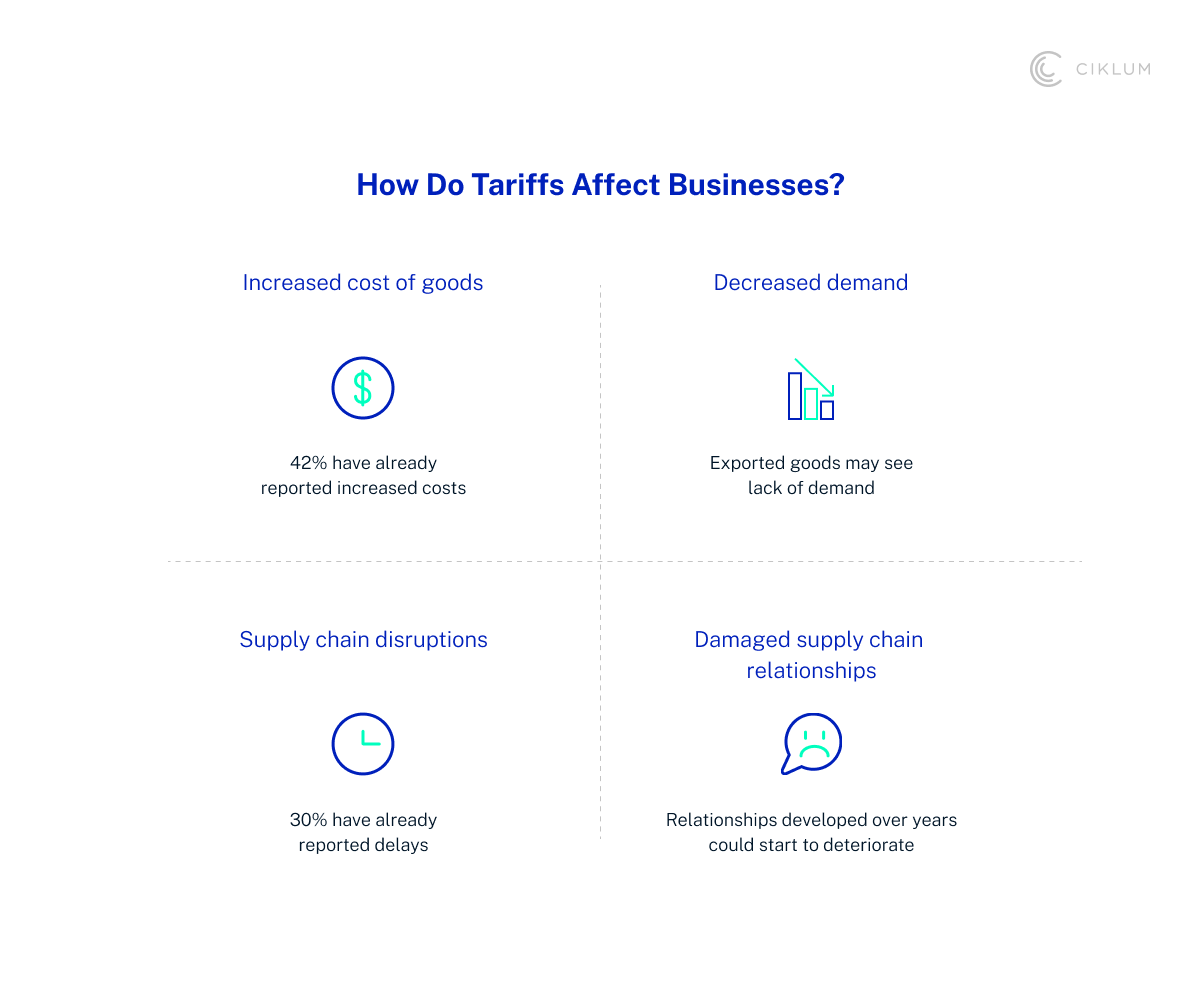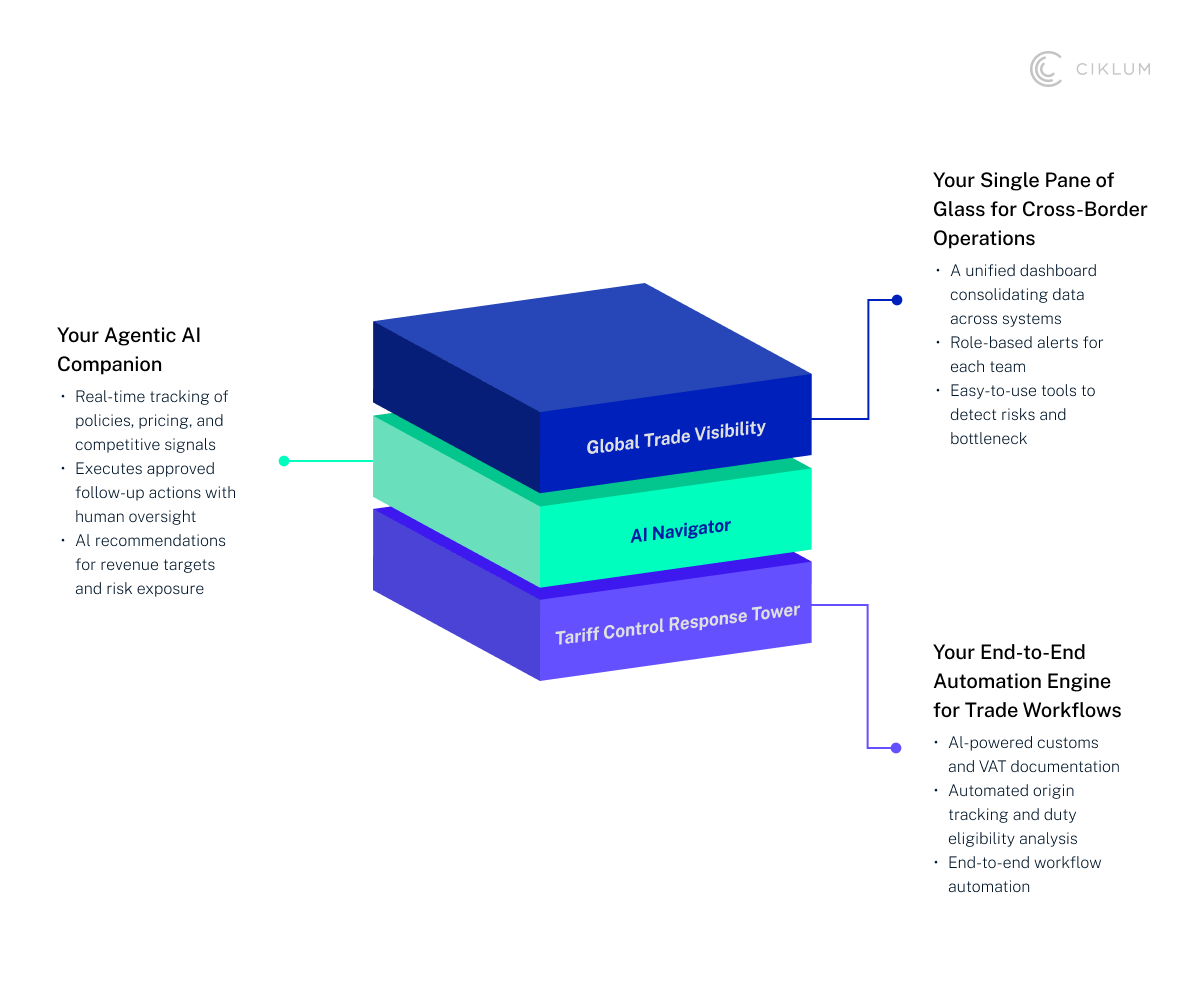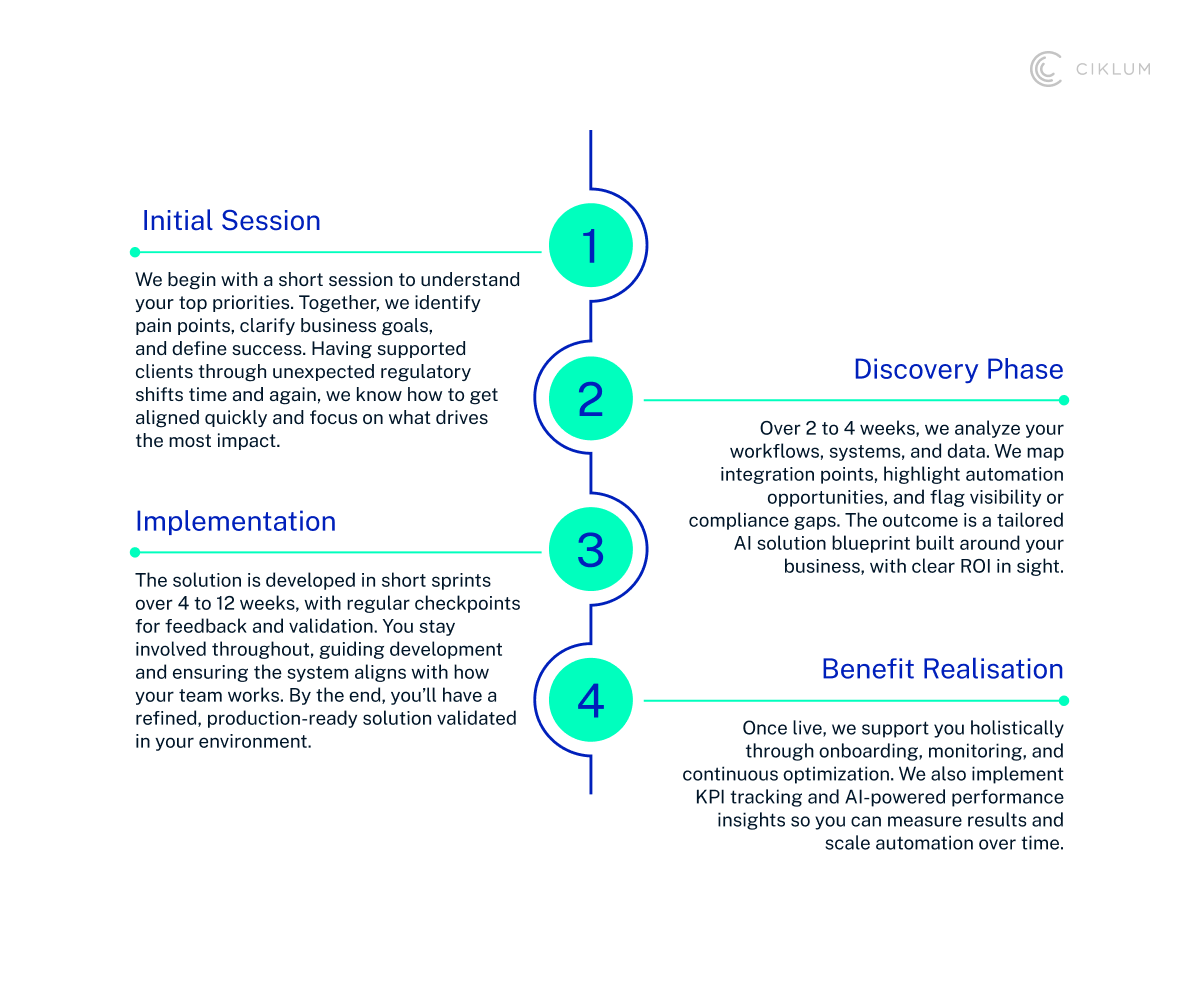- Tariffs Are Changing the Rules of Global Trade
- The Impact of Tariffs on Businesses
- AI in Action: Four Ways to Mitigate Trade Disruption
- Solving Tariff and Trade Challenges with Ciklum’s Automation and AI Stack
- Our Step-by-Step Approach to AI Implementation
- In Summary: AI Is Your Best Bet Against Tariff Uncertainty
Key Takeaways:
- 96% of senior leaders are concerned about the impact of trade policy.
- Tariff volatility is disrupting how global businesses plan, price, and source.
- AI-powered tools give companies an edge in unstable trade environments.
- Predictive AI is helping businesses anticipate setbacks in time.
Tariffs Are Changing the Rules of Global Trade
Trump-era tariffs have triggered a wave of uncertainty, with knock-on effects reaching far beyond rising costs of goods. For companies dependent on overseas suppliers, sudden policy shifts strain budgets, add new layers of paperwork, delay timelines, and force difficult choices across the product lifecycle.
We’re already seeing the impact in the automotive industry. A 25% tariff on imports from most countries and a 10% universal tariff have magnified costs almost overnight. As many U.S.-made vehicles rely on imported components, even entry-level models could cost $2,500–$5,000 more. For automotive and manufacturing firms, that means revisiting supplier contracts and absorbing price shocks. A clear sign that a single policy shift can send ripple waves across your entire value chain.
According to the 2025 State of Manufacturing and Supply Chain report, 96% of senior leaders are concerned about current trade policies. Businesses now need a smarter system to overcome these trade uncertainties. One that predicts disruption, simulates impact, and responds with speed.
That’s the role AI and automation are built for. They’re central to how modern businesses can stay vigilant in a trade environment that changes by the headline.

The Impact of Tariffs on Businesses
Tariffs have real, immediate consequences for businesses worldwide. From manufacturers to retailers to tech-driven supply chains, the effects are already being felt in five key ways:
Rising Costs
Tariffs raise the price of imported goods, raw materials, and critical components. Businesses have no choice but to absorb the cost or pass it on to customers. Both impact profitability and dampen customer loyalty. 42% of businesses have already reported increased costs as a result of new tariff policies.
Supply Chain Delays
New tariffs can jam the inflow and outflow of goods across borders. Customs backlogs, re-routed logistics, and supplier exits are common. If current tariffs persist, the U.S. could see zero growth in 2025, largely due to supply chain strain. Many companies are now under pressure to rethink supplier strategies and smart logistics solutions.
Increased Regulatory Pressure
Every new tariff adds complexity with more paperwork, tighter compliance rules, and increased audit risk. To stay aligned with shifting policies, businesses must revise internal controls and reporting processes, leading to higher overhead and a greater chance of costly errors.
Shrinking Global Demand
Reciprocal tariffs abroad make items and parts more expensive in international markets. That can erode competitiveness, slow expansion, and push customers toward local alternatives, especially in price-sensitive regions.
Friction in the Customer Experience
For an average consumer, tariffs translate into higher prices, delayed deliveries, and limited product availability. That frustration can weaken brand trust and overwhelm support teams trying to maintain customer satisfaction in unpredictable conditions.

AI in Action: Four Ways to Mitigate Trade Disruption
As tariff pressures mount, the need for real-time visibility and disruption forecasting has never been greater. In today’s volatile trade conditions, AI is helping businesses make faster decisions and take the reins across the supply chain.
Here’s how AI is already making a difference:
Real-Time Decision Making
AI-powered platforms pull live data on inventory levels, supplier pricing, and availability. They flag risks early and look out for better options fast.
Smarter Sourcing Strategies
AI can scan global supplier networks, evaluate potential costs, and assess reliability. These insights help businesses shift away from tariff-hit regions and support cost optimization through AI-driven decision-making.
Stronger Inventory Planning
By analyzing historical sales data, market trends, and economic indicators, AI helps forecast demand more accurately. We’re talking about less overstocking, fewer shortages, and smarter production planning.
Proactive Disruption Management
Predictive AI platforms can anticipate policy shifts before they happen. Leading organizations are already analyzing data to secure alternative suppliers months before tariffs affect their existing pipeline.
To see where things are headed, check out our breakdown of the top AI and automation trends to watch in 2025.
Solving Tariff and Trade Challenges with Ciklum’s Automation and AI Stack
From Brexit to COVID-19 to the latest tariff changes, supply chains have faced disruptions at every turn. In 2025 and beyond, businesses that aren’t embedding AI and automation into their operations will quickly fall behind competitors who are.
At Ciklum, we’ve built future-ready solutions designed not just to address today’s tariff changes, but to deliver long-term stability across global trade operations.
Global Trade Visibility – Your Single Pane of Glass
When your supply chain spreads across regions, it’s common to miss something crucial. Our Global Trade Visibility platform puts everything in one place. From inventory status to customs documentation, it gives you total transparency and real-time insight into your trade operations.
AI-Navigator – Your Agentic AI Companion
What if you had a smart assistant that could track the latest headlines, predict the next business disruption, and guide your next move? That’s exactly what AI-Navigator is built for. More than a traditional AI tool, this Agentic AI solution continuously monitors policy shifts and delivers strategic recommendations to counter any impending impact. Once reviewed and approved by your team, it can even take action or trigger follow-ups, so nothing slips through the cracks.
Tariff Response Control Tower
Tariff changes create a cascade effect of manual, time-consuming tasks. Customs declarations, product classifications, VAT reconciliations, you name it. Powered by AI and built on a low-code automation framework, our Tariff Response Control Tower orchestrates your trade workflows from start to finish. It extracts, classifies, validates, and processes key data, so your teams don’t have to.

Our Step-by-Step Approach to AI Implementation
Deploying AI and automation across global trade operations doesn’t require a major overhaul.
At Ciklum, we follow a focused, structured approach to deliver value at every step. We’ve helped businesses respond to regulatory change with speed and flexibility for years, and we bring that experience into every phase of the process.

In Summary: AI Is Your Best Bet Against Tariff Uncertainty
This next evolution in AI may have arrived just in time. As trade disruptions become more frequent and harder to predict, AI and automation are quickly proving to be the most practical path forward. No business wants to face this new era of politically driven tariffs without a plan.
So, where’s the challenge? It’s in integrating AI across complex systems and processes. Something that requires deep expertise, solid infrastructure, and clear strategic direction.
At Ciklum, we’ve spent years helping businesses respond to such challenges with flexible, value-driven solutions delivered at speed. That experience now powers how our AI and Automation team works: combining technical depth with real-world insight to engineer solutions that deliver lasting value.
If tariffs and trade policies are putting pressure on your business, now’s the time to rethink your response. Talk to the Ciklum team to explore how AI can help you steer ahead with confidence.



































